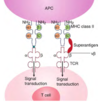Immunology Flashcards
Immune dysregulation, polyendocrinopathy, and enteropathy X-linked
(IPEX)
FoxP3 mutation (Treg express CD4, CD25, and FoxP3). A fatal autoimmune disorder characterized by a triad of watery diarrhea (~100%), eczema (~95%), and endocrinopathy (type I DM [~75%], cytopenias [~50%], thyroiditis [~40%]).
Diagnosis: Flow cytometry for intracellular FoxP3 expression in CD4+/CD25+ T cells (Tregs). The definitive diagnostic test is the mutation analysis FoxP3 gene.
Therapy: Immunosuppression (e.g. sirolimus) prior to definitive therapy. Definitive/curative therapy: HSCT.

Which TLRs are present in the intracellular compartment and implicated in HSV1 encephalitis?
TLR 3, 7, 8, and 9
Antigen processing and MHC Presentation (MHC I Pathway)
Key Factor: Viruses develop strategies to evade the MHC I presentation. HSV can block TAP transportation, CMV can remove MHC I form ER.

What enzyme is required for somatic hypermutation?
Key fact: CD40 ligand - CD40 interaction stimulates AID, which is crucial for SHM and isotype switching
What cytokines induce IgD class switching?
None
Do not require isotype switching, exact function unknown, B-cell maturation marker
Immune complexes tend to be the largest under which of the following conditions?
Extreme antibody excess
What is released by epithelial cells to maintain mucosal mast cells at the airway and skin surface?
Stem cell factor (SCF)
IgG and IgM activate which complement pathway?
Classical pathway
What is the target of RF, and what is the most common RF Ig isotype?
RF is an antibody against the Fc portion of IgG. RF is most commonly IgM.
Chemokines and Associated Conditions

Peripheral Tolerance and Maintenance
(T-lymphocytes)
Same outcomes as central tolerance: Anergy, deletion, or regulation. Lack of the second signal produces the anergy of the peripheral T lymphocytes (maintain by blockade of TRCsignaling, ubiquitin ligases, and inhibitor costimulatory molecules [e.g., CTLA-4 and PD-1]).
Maintenance of tolerance: Non-activated DC do not express receptors → Ag presented to T lymphocytes will not have a second signal ⇒ Tolerance
Key Fact: Treg (express CD4, CD25, FofP3) is critical in maintaining normal immune function.
Ig Structure
(heavy chains, light chains, Ig Fragments, hinge regions, variable regions, constant regions)
Heterodimer w/ 2 identical light chains and 2 identical heavy chains connected with disulfide bonds.
<span><b>Heavy chains</b></span> (γ, α, μ, ε, δ): IgG (IgG1, IgG2, IgG3, IgG4), IgA, and IgD have 3 CH domains. IgA and IgE have 4 CH domains.
<span>Light chains</span> (κ [chromosome 2] and λ [chromosome 22]): An IgG molecule has either κκ (60%) or λλ (40%) but never 1 of each.
Ig Fragments: Papain: cleaves Ig above the hinge ⇒ 2 Fab (can bind but not cross-link); Pepsin: cleaves Ig below the hinge ⇒ Fab’2 (binds and cross-link). Neither Fab nor Fab’2 will fix complement or bind to the Fc receptor on the cell surface.
Hinge regions: Proline-rich and provide Ig flexibility.
Variable regions (VL and VH): Ag-binding site (CDRs [there are 3 in each V region, CDR3 is the most variable])
Constant regions (CH and CL): C-terminal. Only CH mediates effector functions (binding to Fc receptors or binding complement).
Glycosylation: Critical to maintaining structure/stability/function (e.g., IgG has its glycosylation site at the Cγ domain, deglycosylated IgG cannot bind to FcγRs and C1q ⇒ ADCC and complement activation.

Classical Complement Pathway
- Activate by C1 binding to Ag-Ab complexes
- C1q binds to the Fc portion of an Ig cross-linked Ag
- Binding affinity of C1q: IgM > Ig3 > Ig1 > Ig2
- C1q - C1r → C1s → C4 / C2 ⇒ C4b2a (C3 convertase of the CP)
- C1 inhibitor → C1r - C1s (regulating the pathway)
- C4b → DAF (CR1 and C4BP) ⇒ Blocks further progression of the cascade

Which somatic recombination process introduces the greatest diversity in immune receptors and which enzyme is important in this process?
Junctional diversity; TdT enzyme is important in this process.
What cytokines induce IgG (1, 2, 3, 4) class switching?
- IgG1: INFγ and IL-4 (Th1 response, opsonization, best for ADCC)
- IgG2: INFγ and TGFβ (antipolysaccharide-Ab, the latest to reach an adult level of all IgG subclasses)
- IgG3: INFγ (shortest half-life in IgG-subclasses, opsonization)
- IgG4: IL-4 and IL-13 (antipolysaccharide-Ab, elevated in immunotherapy)
IPEX-like Disorders
IPEX-like Disorder (CD25 deficiency): Chronic diarrhea and villous atrophy in infancy, type 1 DM, auto-antibodies, lymphadenopathy, hepatosplenomegaly. Early-onset CMV pneumonitis, candidal esophagitis, chronic GI infections.
IPEX-like Disorder (STAT5b Deficiency): Early-onset diarrhea, eczema, lymphocytic interstitial pneumonitis. Dwarfism, prominent forehead, saddle nose, and high pitched voice. Recurrent PCP, herpes, and varicella infections.
Decreased CD25 expression and Tregs, normal GH but depressed IGF-1 levels.
Anti-C1q Antibody
Autoantibody to the collagen-like region of C1q found in patients with hypocomplementemic urticarial vasculitis (HUVS → responsive to Plaquenil)
Structure of MHC Class I and Class II Molecules (Table)

AIRE
The autoimmune regulatory (AIRE) gene is expressed in the thymus. This gene promotes the expression of nonthymic tissue antigens in the thymus.
Key Fact: Mutation in the AIRE gene produces disorders such as autoimmune polyglandular syndrome (APS). Lymphocytes are not deleted or tolerized to endocrine-related self-antigens. The endocrine organs are attacked by autoreactive T lymphocytes and autoantibodies.
How long after drug initiation does serum sickness typically develop in a patient with no prior exposure to the medication in question?
1-3 weeks (other option 4 - 10 days)
What are the primary immunoglobulins involved with type II hypersensitivity?
IgM and IgG
What CD molecules are in the BCR coreceptor?
CD21, CD19, and CD81
What has been shown to be the earliest event in an active Arthus reaction?
Immune complex and complement deposition
Lectin Complement Pathway
- Activitated in the absence of Ab
- Mannose-binding lectin (MBL) binds to mannose residues on microbial polysaccharides, MBL-associated protease-1 and -2 → cleaves C4 and C2 ⇒ C3 convertase C4b2a
- C3 convertase cleaves C3 to C3b which binds to the convertase and forms C5 convertase (C3bBb3b in the AP and C4b2a3b in the CP and LP)























